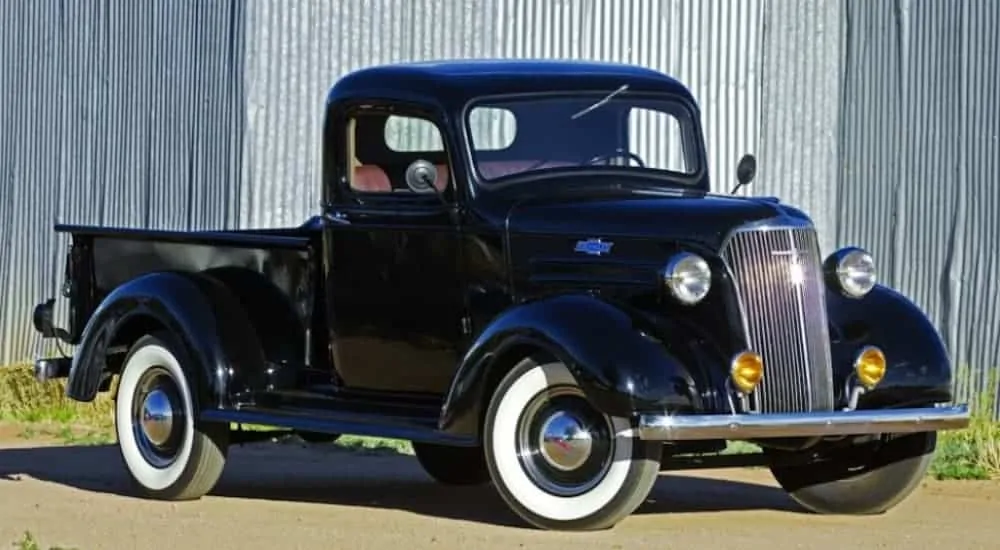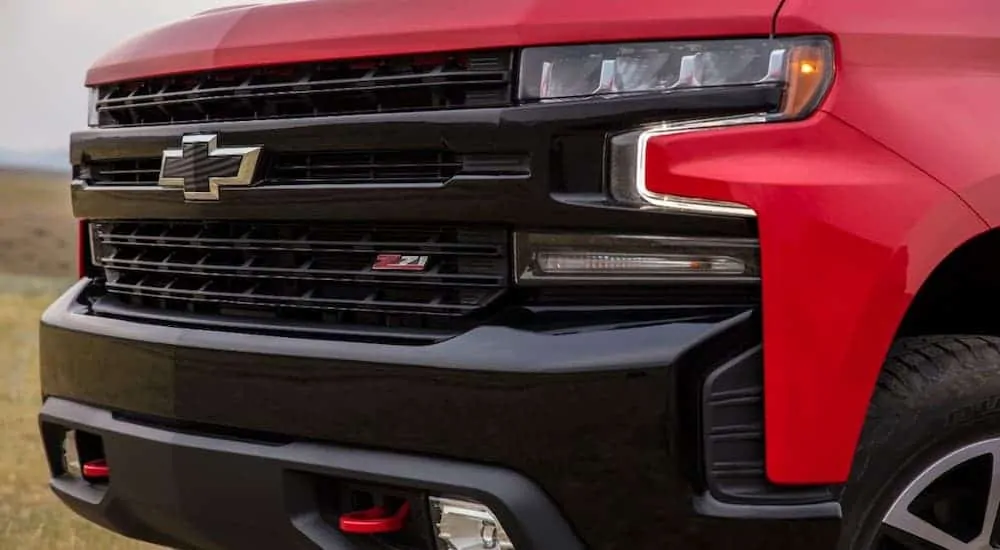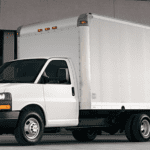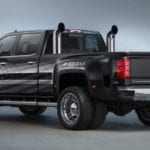From heavy-duty work trucks to daily drivers for those who need extra cargo and towing capacity, Chevy trucks have embedded themselves in the American spirit. For over one hundred years, Chevrolet has been producing the trucks that take Americans to the worksite, tow full trailers, pull campers, boats, and off-road vehicles through the woods and to the lake, and take drivers wherever destination the road has in mind. The evolution of Chevy trucks has taken drivers from an America that drove on wooden wheels and muddy streets to a country where Bluetooth hands-free connectivity is an important vehicle feature. As the needs of the American public have changed and the country has grown, the capability of Chevy trucks has met the needs and desires of the many, following the road of progress from the farm to the city and back again. One hundred years of progress may not seem like very long, but looking at Chevrolet’s landmark moments over that century paints a clear picture of the changes in lifestyle and technology across the United States.
The Early Years
The Chevy Truck Evolution begins with the Model T, in the way off days of 1918. “T,” of course, stood for “truck,” Chevy offered the Model T in a variety of configurations. The ½ ton model included a rolling chassis and a 3.7L engine that offered a historically considerable 36 horsepower. The chassis retailed for a whopping $1325, while the express 1 ton model had a $1460 price tag, which converts to around $17-20,000 in today’s currency. Buyers were required to add their own body to the vehicle, allowing it to be customized as a van, a flatbed, or a cargo-style truck.
In 1929, Chevy released the iconic Stovebolt, so named because the fasteners looked like fixtures on the wooden stoves used to heat most homes at the time. This truck was designed for delivery purposes, as the transport of goods expanded and there had to be some means to bring mail-order goods from the rail line to the storefront or home. This was the first truck in the industry to sport an OHV 6 cylinder engine, and offered a blistering 46 horsepower. The retail price averaged around $500, depending on model options, and was the first truck to have an enclosed cab for safe all-weather driving.

Technology in 1937 and 1938 was led by both the jet engine and the ballpoint pen. Americans were deeply interested in convenience and power. The 1937 Chevy Half-Ton truck offered both. This was the year in which aesthetic design was introduced to the truck by the newly established Art & Color Department and Harley Earl. Offering 78 horsepower, the Half Ton took a long distance trip and recorded a fuel economy of 21 miles per gallon, which remains a popular mark in the industry today. The influence of art and design continued with the 1947 Advance Design, which included a ThriftMaster engine, and began introducing features enjoyed today, such as parking lights, a single-piece windshield, and an updated steering wheel to add comfort to the drive.
Mid-Century Trucking
The Advanced Design was discontinued in 1954, and in 1955, Chevrolet introduced the 3124 Cameo Carrier. This was the year the General Motors small-block V8 engine was introduced, giving Chevy a lead over competitors with a whopping 123 horsepower and 207 lb-ft of torque. The Cameo Carrier had but one aesthetic: two-tone ivory and red paint. Features introduced on what became known as the “Task Force” truck, which retailed for around $1981, included the wrap-around windshield, egg crate grille, and concealed running boards. It also had the first iteration of the iconic fleetside design, which made its way back into the Chevy lineup with the 2003 SSR.
Everybody’s favorite crossover, the El Camino, was introduced in 1959. Is it a truck? Is it a car? Sporting both fins and a sizeable truck bed, the El Camino is now classified as a “coupe-utility” vehicle, that sprang naturally out of the success of the Cameo Carrier. Interestingly enough, the El Camino was the first of Chevrolet’s vehicles to feature a steel bed, instead of a wooden bed. It also included the option of a turbocharged V8 engine, giving it significantly more power than previous trucks. While future generations leaned more into the sedan aspects of a coupe-utility, the first El Camino, which retailed for around $2300, was intended to look good and move up to 1,150 pounds of payload.
The 1950s and 1960s seem to be the age of flamboyant styling, and the 1967 Chevrolet C/K Series was not exempt from a surge of style. Its official nickname was “The Action Line,” but features like metallic paint earned it the fond moniker “The Glamour Line.” Now offering a variety of trim packages and engine options, including a 6-cylinder and a big block V, the C/K Series was specifically advertised as being equally capable of work and play duties. With a family-friendly price tag of $2408, it was perfect for taking the kids to the lake on weekends, and still being able to complete its work duties Monday through Friday.
The third generation of the C/K ran from 1973 to 1987, making it the longest-running body in Chevy history, and earned notoriety as the first trucks with a standard passenger side mirror, dually configuration, and integrated window antenna. These trucks are considered the first modern heavy-duty pick up.
The Turn of the Century Truck
The 1988 Chevy C/K Series 1500 was the first pickup to be designed with aerodynamics in mind. Turmoil in the fuel industry led Americans to become more conscientious of design choices and mile per gallon ratings, while increased workloads and payloads led to features like independent front suspension and InstaTrac, which allowed drivers to shift in and out of four-wheel-drive. Retailing at approximately $12,747, the 1988 C1500 Sport won notoriety when it maintained 103mph for twenty-four hours, completing almost 1000 laps, and taking home the Hulman Indy Challenge Trophy, thus proving a Chevy truck could provide power, speed, and go the distance.
In 1994, Chevy introduced the S10 ZR2, its first offering for fully off-road capability. The ZR2 was designed to be wider, with greater ground clearance. Featuring 31-inch tires, larger axles, skid plates, and a Panhard rod for the leaf-sprung rear, the ZR2 was seen eagerly making its way up sand dunes, and through appropriately rugged terrain. It’s easy to imagine the ZR2 and the Model T faced similar conditions on their journeys, including deep muddy and rocky roads, but the ZR2 was blessed with modern technology, while the Model T had to adapt. Off-road enthusiasts who took advantage of the ZR2’s extra clearance and bold stance need only consider an ancestor, just seventy-six years early, trying to do the same on wooden wheels.
1999 was a banner year for the Silverado 1500. Previously introduced as a trim package, Silverado earned its own place in the Chevy lineup right before the turn of the century. Equipped with a Vortec V8 engine that offered 270 horsepower and 320 lb-ft of torque, the Silverado retailed for $31,384, which put a pretty price on a whole lot of power.
The Chevy of Today
For its 100th production year, Chevrolet made sure their pickup trucks were launched with incredible engineering, design, and capability. So much had changed in just one hundred years. Gasoline is now readily available every few miles. Electricity is available. The assembly lines throughout the country can prepare automobiles efficiently, and railways can ship them anywhere in just a few days. Not only does the American public have easy access to telephones, but they carry them in the car and require Bluetooth to use those phones while driving. Seats are comfortable. Safety features expand beyond the passenger side mirror, and include rearview cameras, 7-inch touchscreen displays, and connectivity to apps like Apple CarPlay and Android Auto. The Silverado 1500 introduced in 2018 included all of these features as standard, and as the years progress, each trim level earns more bells and whistles to aid drivers in longer commutes and going further distances with greater payloads.
The evolution of the Chevy truck is a reflection of the evolution of America. As technology has progressed, the American appetite for more features, more power, and more functionality has increased. While the main objective of getting people and cargo from here to there remains, safety and comfort have come to the forefront, with increased capabilities being added annually, leading to “new and improved” models for truck enthusiasts to look forward to each year.





